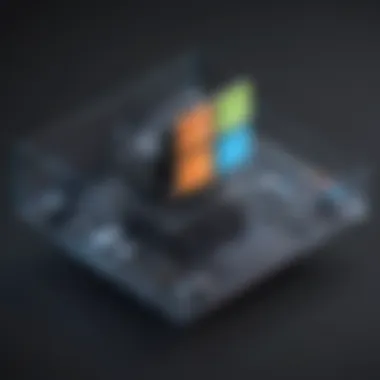Unveiling the Performance Disparity: Windows 11 Versus Windows 10


Overview of Windows Performance Issues
When delving into the comparison between the performance of Windows 11 and its predecessor Windows 10, one cannot ignore the noticeable lag experienced by users of the newer operating system. Exploring the technical intricacies and user feedback is essential to understanding the reasons behind Windows 11's slower performance. By analyzing these aspects meticulously, we aim to shed light on the implications for users and provide valuable insights into potential optimization strategies.
Technical Aspects and User Experiences
The disparity in performance between Windows 11 and Windows 10 has been a subject of debate amongst users and tech enthusiasts alike. Technical aspects such as system resource utilization, optimization of processes, and user interface enhancements play a crucial role in shaping the user experience. By examining user feedback and real-life performance scenarios, we can gain a comprehensive understanding of why Windows 11 falls short in terms of speed and responsiveness.
Implications for Users and Optimization Strategies
For individuals who rely on efficient computing, the slower performance of Windows 11 can pose significant challenges. Whether it be slower boot times, application loading delays, or overall system responsiveness, these performance issues can impact productivity and user satisfaction. Therefore, exploring optimization strategies, tweaking system settings, disabling unnecessary background processes, and utilizing performance-enhancing tools are essential considerations for users looking to enhance their Windows 11 experience.
Best Practices for Improving Windows Performance
In the quest for seamless computing with Windows 11, adhering to best practices can significantly boost system performance and user satisfaction. From optimizing system settings and managing background processes to utilizing software tools for enhancing performance, there are various strategies that users can employ to bridge the performance gap between Windows 11 and its predecessor, Windows 10. It is crucial to explore these best practices in depth to empower users with the knowledge and tools needed to optimize their Windows 11 experience to the fullest.
System Optimization and Resource Management
One of the fundamental aspects of improving Windows 11 performance is efficient system optimization and resource management. By fine-tuning system settings, disabling unnecessary startup programs, and managing system resources effectively, users can enhance system responsiveness and overall performance. Additionally, exploring advanced system optimization tools and techniques can further elevate the performance capabilities of Windows 11, ensuring a seamless computing experience.
Application Tuning and Performance Enhancement
Apart from system-level optimizations, tuning individual applications and optimizing their performance can contribute significantly to improving overall system speed and responsiveness. By exploring application-specific performance tweaks, resource allocation settings, and update management strategies, users can ensure that applications run smoothly and efficiently on Windows 11. Additionally, utilizing performance-enhancing tools and monitoring software can help identify performance bottlenecks and optimize application performance for enhanced user experience.
Hardware Upgrades and Compatibility Checks
In some cases, hardware limitations or compatibility issues may contribute to the slower performance of Windows 11 on certain systems. By conducting thorough hardware compatibility checks, upgrading critical system components, and ensuring driver compatibility and optimization, users can address hardware-related performance issues and unlock the full potential of Windows 11. Delving into hardware upgrades, compatibility assessments, and performance optimizations can provide valuable insights into overcoming performance barriers and maximizing the efficiency of Windows 11 on diverse hardware configurations.
Synthesizing Information for Optimal Performance Enhancement
As we navigate the intricate landscape of Windows 11 performance analysis and optimization strategies, synthesizing the information presented throughout is essential for deriving actionable insights and practical recommendations. By consolidating technical knowledge, user experiences, and best practices for improved performance, users can gain a holistic understanding of the steps needed to enhance Windows 11 performance effectively. Through a comprehensive synthesis of information, users can empower themselves with the knowledge and tools required to optimize their Windows 11 experience and bridge the performance gap with its predecessor, Windows 10.
Actionable Recommendations and Performance Enhancement Tips
In the pursuit of optimal performance with Windows 11, actionable recommendations and performance enhancement tips play a pivotal role in guiding users towards a more efficient computing experience. By distilling complex technical concepts into actionable insights, providing step-by-step guidance on performance-enhancing strategies, and offering practical tips for overcoming common performance hurdles, users can navigate the realm of Windows 11 performance optimization with confidence and efficacy. Empowering users with actionable recommendations and performance enhancement tips is essential for equipping them with the knowledge and tools needed to unleash the full potential of Windows 11 and elevate their computing experience to new heights.
Introduction
Exploring the reasons behind the slower performance of Windows 11 in comparison to Windows 10 is a pertinent and insightful topic that captivates the interest of technology enthusiasts and users seeking optimal system efficiency. By delving into this analysis, we can unravel the intricate layers of technical disparities and user experiences that contribute to this performance divergence.
Overview of Windows and Windows
Evolution of Windows Operating Systems
The evolution of Windows operating systems has been a gradual progression towards enhanced functionalities and user experiences. Windows 11 represents a milestone in this evolution with its focus on modernization and improved security protocols. The incorporation of innovative features such as Virtual Desktops and Snap Layouts sets Windows 11 apart, offering users a more streamlined and visually appealing interface. While these advancements bolster user productivity, they also pose challenges in terms of system resource allocation and compatibility with existing software.
Key Features of Windows
The key features of Windows 11 encompass a myriad of advancements aimed at redefining the user experience. From the enhanced Microsoft Store layout to the integration of Microsoft Teams, Windows 11 seeks to bridge the gap between work and play seamlessly. However, the introduction of these features brings about an increased demand on system resources, leading to potential performance bottlenecks when compared to its predecessor, Windows 10.


Differences in User Interface
The user interface disparities between Windows 11 and Windows 10 are notable, with Windows 11 embracing a more modern and minimalist design approach. The centered Start Menu and taskbar icons represent a departure from the traditional layout of Windows 10, aiming to provide a more visually cohesive user experience. While these changes cater to contemporary design preferences, they also present a learning curve for existing Windows users accustomed to the layout of Windows 10, potentially impacting user efficiency and satisfaction.
Performance Metrics
In the realm of operating systems, delving into Performance Metrics is crucial for assessing the efficiency and effectiveness of Windows 11 in comparison to its predecessor, Windows 10. By scrutinizing various performance indicators, such as boot time, application launch speed, resource consumption, graphics performance, and storage utilization, users can gain profound insights into the operational capabilities and limitations of each system. Understanding these metrics is paramount for users concerned about optimizing their online security and privacy while maintaining a seamless computing experience.
Benchmark Tests
Speed Tests: Boot Time and Application Launch
Examining the speed at which Windows 11 boots up and launches applications provides a direct evaluation of its operational swiftness. Comparing these processes with Windows 10 offers a tangible perspective on the efficiency disparity between the two systems. The boot time and application launch speed are pivotal factors contributing to overall user experience; hence, meticulous analysis of these metrics sheds light on the core performance differences and aids in determining the impact on productivity.
Resource Consumption: RAM and CPU Usage
The analysis of resource consumption, focusing on RAM and CPU usage, offers valuable insights into the operational resource demands of Windows 11. By comparing these metrics with Windows 10, users can discern the evolving resource requirements of the newer operating system. Understanding the nuances of resource utilization aids in optimizing system performance and ensuring smooth multitasking capabilities without compromising online security or privacy.
Graphics Performance: Gaming and Multimedia
Evaluating the graphics performance concerning gaming and multimedia activities unveils the graphical proficiency of Windows 11 in handling demanding visual tasks. Contrasting this aspect with Windows 10 elucidates the advancements or setbacks in graphical capabilities. This measurement is pertinent for individuals seeking an immersive multimedia experience while prioritizing system performance and responsiveness.
Storage Utilization: Disk Speed and Efficiency
Assessing the storage utilization metrics, particularly focusing on disk speed and efficiency, provides a comprehensive understanding of the data handling capacities of Windows 11 compared to Windows 10. By scrutinizing these metrics, users can gauge the efficiency of data storage, access speeds, and overall system responsiveness. Optimizing storage utilization is paramount for individuals aiming to maintain data integrity and system performance while upholding stringent online security measures.
Real-World Performance
Impact on Productivity Tasks
Analyzing the impact of Windows 11 on productivity tasks offers significant insights into the practical usability and efficiency of the operating system. By evaluating its performance in handling everyday productivity applications, users can gauge the system's compatibility with work-related tasks. Understanding the impact on productivity tasks aids in fine-tuning system settings and optimizing user experience without compromising data security.
Multitasking Capabilities
Assessing the multitasking capabilities of Windows 11 compared to Windows 10 provides a holistic view of the system's ability to concurrently manage multiple tasks. By scrutinizing the system's multitasking efficiency, users can assess its suitability for handling diverse workloads and applications simultaneously. Optimizing multitasking capabilities ensures seamless task management while safeguarding online security and privacy measures.
Responsiveness and Lag
The examination of system responsiveness and lag uncovers the operational smoothness and potential performance bottlenecks of Windows 11 in real-world scenarios. By identifying instances of lag or delays in system responses, users can address performance issues proactively and fine-tune system settings for optimal responsiveness. Ensuring system responsiveness is paramount for users emphasizing operational efficiency and data security in their computing endeavors.
Underlying Factors
In delving into the intricacies of the performance disparities between Windows 11 and Windows 10, understanding the underlying factors becomes paramount. These factors serve as the foundation upon which the entire comparison is built. By closely examining the system requirements and optimization challenges, it is possible to gain a detailed insight into why Windows 11 falls short in performance compared to its predecessor. Unraveling these fundamental aspects not only sheds light on technical issues but also reveals essential considerations for users seeking to enhance their system's speed and efficiency.
System Requirements
Hardware Compatibility:
Hardware compatibility plays a crucial role in determining the effectiveness of an operating system. In the context of Windows 11 versus Windows 10, the compatibility of hardware components with the newer OS proves to be a significant factor contributing to the performance gap. The ability of hardware devices to seamlessly integrate with Windows 11 impacts overall system speed and stability. However, compatibility issues arising from older hardware configurations can lead to slower performance and potential system glitches. While embracing new hardware can enhance the user experience, it may pose challenges for users with existing systems not optimized for Windows 11.


Resource Demands:
Resource demands refer to the amount of system resources, such as RAM and CPU usage, required by an operating system to function optimally. In the case of Windows 11, higher resource demands compared to Windows 10 can result in sluggish performance and decreased efficiency. The increased resource utilization by Windows 11 strains system components, leading to slower responsiveness and performance bottlenecks. Understanding and addressing these heightened resource demands are crucial in optimizing system speed and enhancing user experience.
Minimum Specifications:
The minimum specifications outlined by Microsoft for Windows 11 highlight the hardware requirements necessary for running the operating system effectively. While meeting these specifications is essential for optimal performance, it poses a challenge for users with older systems that may not meet the stringent requirements of Windows 11. Failing to meet the minimum specifications can greatly impact system speed and functionality, making it imperative for users to upgrade hardware or consider alternative optimization strategies to mitigate the performance gap between Windows 11 and Windows 10.
Optimization Challenges
Software Integration Issues:
Software integration issues encompass compatibility problems between third-party applications and the operating system. In the context of Windows 11, software integration issues contribute significantly to performance disparities with Windows 10. Compatibility issues arising from outdated or incompatible software can result in system slowdowns and errors, hampering overall user experience. Resolving software integration challenges involves updating software versions and ensuring compatibility with Windows 11 to enhance system speed and functionality.
Driver Compatibility:
Driver compatibility plays a critical role in ensuring the seamless operation of hardware components with the operating system. In the comparison between Windows 11 and Windows 10, driver compatibility emerges as a key optimization challenge impacting system performance. Outdated or incompatible drivers can impede hardware functionality, leading to decreased system speed and responsiveness. Updating drivers to align with Windows 11 requirements is essential in overcoming driver compatibility issues and optimizing system performance.
Background Processes:
Background processes encompass the running applications and services that operate behind the scenes in an operating system. In the context of Windows 11, managing background processes is crucial for mitigating performance issues compared to Windows 10. Excessive background processes can consume system resources, slowing down overall system performance and responsiveness. Optimizing background processes by disabling unnecessary applications can significantly improve system speed and efficiency, addressing one of the key optimization challenges between Windows 11 and its predecessor.
User Experiences
User experiences play a pivotal role in the examination of the slower performance of Windows 11 in comparison to Windows 10. Understanding how users interact with the operating system provides valuable insights into the issues faced and the features appreciated. The user experience encompasses various elements such as ease of navigation, responsiveness of the interface, and overall satisfaction with the system. By focusing on user experiences, this article aims to dissect the practical implications of performance disparities between Windows 11 and Windows 10, offering a user-centric perspective on the matter.
Feedback and Reviews
Community Response:
The community response serves as a fundamental aspect in gauging the reception of Windows 11 and its performance relative to Windows 10. Analyzing the collective feedback from users within online forums, social media platforms, and community discussions sheds light on common trends and issues faced. The community response offers a diversified range of opinions, reflecting both positive and negative experiences with the operating system. Understanding the community response provides valuable insights into widespread concerns or benefits, contributing significantly to the overarching analysis of performance differences between Windows 11 and Windows 10. While the community response offers a broad spectrum of perspectives, it is essential to critically evaluate the feedback to distill key takeaways for a comprehensive understanding.
Technology Experts' Opinions:
Technology experts' opinions serve as a crucial pillar in understanding the technical nuances behind the slower performance of Windows 11 in comparison to Windows 10. Leveraging the expertise of industry professionals, software developers, and IT specialists provides deep insights into the underlying factors contributing to performance differentials. Experts offer critical evaluations of system architecture, resource optimization, and software integration, offering valuable perspectives on the challenges faced by Windows 11. By delving into technology experts' opinions, this article aims to provide readers with an informed and expert-backed analysis of the performance gaps between the two operating systems. Expert opinions add a layer of technical insight that complements user feedback, enriching the narrative with precise technical details and industry perspectives.
User Satisfaction Surveys:
User satisfaction surveys stand as a quantitative approach to evaluating user experiences and perceptions of Windows 11 in comparison to Windows 10. By aggregating responses from structured surveys and feedback forms, this section seeks to quantify user satisfaction levels, identify common pain points, and highlight notable areas of improvement. User satisfaction surveys offer a data-driven perspective on user sentiments, enabling a systematic analysis of user experiences across different performance metrics. Through detailed analysis of user satisfaction surveys, this article aims to present a holistic view of user opinions and sentiments, backed by statistical data and measurable insights. Surveys provide a structured framework for understanding user preferences, usability issues, and overall satisfaction levels with Windows 11, contributing to a robust assessment of its performance relative to Windows 10.
Common Performance Complaints
Issues with Start Menu and Search:
The functionality of the start menu and search features constitutes a common performance complaint among users transitioning to Windows 11 from Windows 10. Issues related to search responsiveness, search accuracy, and start menu functionality impact user workflow and overall system usability. By delving into the intricacies of start menu and search challenges, this section aims to outline the specific pain points experienced by users, shedding light on the discrepancies between the two operating systems. Addressing issues with start menu and search functionalities requires a deeper dive into system architecture, algorithm optimization, and user interface design, aiming to provide actionable insights for enhancing user experiences.
Sluggish Behavior in Taskbar:
The occurrence of sluggish behavior in the taskbar presents a notable obstacle in the seamless navigation and operation of Windows 11, contributing to user dissatisfaction and performance concerns. Issues such as delayed taskbar responsiveness, unresponsiveness to user inputs, and inconsistent behavior impede productivity and user experience. Analyzing the factors contributing to sluggish behavior in the taskbar involves examining resource allocation, background processes, and system optimization strategies. By dissecting the intricacies of taskbar performance challenges, this section aims to offer practical solutions and recommendations for mitigating sluggish behavior and enhancing overall system efficiency.


Software Compatibility Challenges:
Software compatibility challenges pose a significant hurdle for users transitioning to Windows 11, impacting the seamless operation of essential applications and peripheral devices. Issues related to driver compatibility, software integration, and legacy application support present real obstacles in user adoption and satisfaction. Understanding the complexities of software compatibility challenges requires a nuanced approach to system configuration, driver optimization, and compatibility testing. By scrutinizing the intricacies of software compatibility issues, this section aims to unravel the underlying causes of performance differentials between Windows 11 and Windows 10, offering actionable insights for addressing compatibility concerns and improving overall system performance.
Optimization Techniques
Optimization techniques play a vital role in this article, where the focus is on dissecting the disparities in performance between Windows 11 and Windows 10. These techniques are crucial for enhancing the speed, efficiency, and overall usability of operating systems like Windows.
When it comes to optimizing the performance of Windows 11, several key elements need consideration. By delving into optimization techniques, users can address and mitigate the challenges that lead to Windows 11's slower performance compared to its predecessor.
Optimization techniques are essential for streamlining operations, maximizing resources, and ultimately improving the user experience. By implementing these techniques, users can unlock the full potential of their operating system and overcome performance bottlenecks.
Improving Windows Speed
Updating Drivers and Software
Updating drivers and software is a critical aspect of enhancing the speed and performance of Windows 11. By ensuring that drivers and software are up to date, users can leverage the latest optimizations, bug fixes, and improvements that can significantly boost system performance.
The key characteristic of updating drivers and software lies in its ability to address compatibility issues, security vulnerabilities, and performance bottlenecks. It is a popular choice for optimizing Windows 11 speed as outdated drivers and software can hinder system efficiency.
Updating drivers and software offers the unique feature of providing access to new features, enhanced stability, and improved compatibility with the latest applications. While this process may require periodic updates, the benefits it brings to performance optimization in this article are undeniable.
Adjusting Power Settings
Adjusting power settings is another crucial aspect of enhancing the speed and efficiency of Windows 11. By fine-tuning power configurations, users can optimize resource allocation, prioritize performance, and minimize unnecessary energy consumption.
The key characteristic of adjusting power settings is its capacity to balance performance needs with power efficiency. This makes it a beneficial choice for optimizing Windows 11 speed as users can customize settings to meet their specific requirements.
The unique feature of adjusting power settings lies in its ability to maximize performance during demanding tasks and conserve power during idle periods. While there may be some trade-offs in certain scenarios, the advantages of tailored power settings for optimizing performance in this article are evident.
Disabling Background Apps
Disabling background apps is a key optimization technique for improving the speed and responsiveness of Windows 11. By preventing unnecessary apps from running in the background, users can free up system resources, reduce clutter, and enhance overall system performance.
The key characteristic of disabling background apps is its impact on resource allocation and system responsiveness. It is a popular choice for optimizing Windows 11 speed as background apps can consume valuable CPU and RAM resources.
Disabling background apps offers the unique feature of decluttering the system environment, minimizing distractions, and improving the focus on active tasks. While some apps may provide background functionality, disabling non-essential ones can lead to a noticeable enhancement in performance in this article.
Conclusion
In exploring the slower performance of Windows 11 compared to Windows 10, it becomes evident that understanding the nuances of operating system performance is crucial for users seeking optimal system functionality. By delving into the technical disparities and user experiences, this analysis offers valuable insights into the reasons behind Windows 11's lag and provides a roadmap for optimization.
Final Thoughts
Implications for Users
Discussing the implications for users sheds light on how the performance gap between Windows 11 and Windows 10 can influence user interactions with their systems. Identifying the key areas where users may experience inefficiencies can assist in making informed decisions regarding system upgrades and software compatibility. By considering the implications for users, this article equips readers with the knowledge to navigate potential performance challenges effectively.
Future Updates and Enhancements
Exploring future updates and enhancements brings attention to the ongoing evolution of operating systems and the continuous strive for improved performance. By highlighting the key characteristics of upcoming updates and enhancements, users are encouraged to stay informed about technological advancements that could enhance their computing experiences. Understanding the potential benefits and drawbacks of future updates allows users to make informed decisions on how to adapt to changing system requirements.
Balancing Performance and Features
The discussion on balancing performance and features emphasizes the importance of striking a harmonious equilibrium between functionality and speed. By uncovering the unique features that contribute to both performance enhancements and user experience, readers can gain insights into optimizing their systems without compromising on essential features. Evaluating the advantages and disadvantages of this delicate balance enables users to tailor their system configurations to meet their specific needs effectively.







